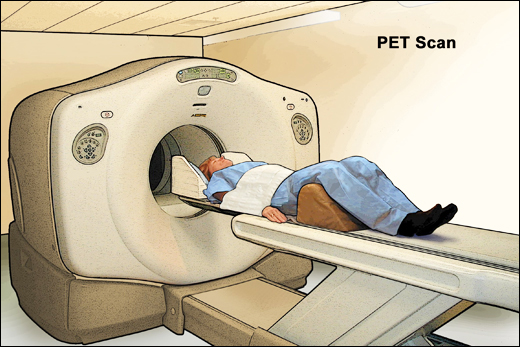What is a PET Scan and How does it work?
Description
Positron Emission Tomography (PET) scan is an advanced imaging technique primarily used in oncology. It provides detailed study and visualization of the organs and tissues as it helps in detecting a wide range of medical conditions such as cancer, neurological disorders, heart disorders and various other disorders. PET scan provides valuable information about the biochemical activity, functions of the cell, detection of any abnormal growth and monitoring of progress of treatment.

What is PET Scan?
Positron Emission Tomography (PET) scan comes under nuclear medicine which helps in studying and visualising the work of organs and tissues of the body. It works by using radioactive material known as tracer which is given either intravenously or orally depending on the site of scanning. The tracer gathers in the high metabolic activity area (metastatic cells) and provides detailed and high resolving images.
How to do PET Scan (Procedure)?
The Few steps of PET scan are following:
- Preparation – Most patients are instructed to fast for at least 4–6 hours before the scan. This is because food and drink can influence the way the radiotracer is absorbed by the body, potentially affecting the scan resultsAsk them to remove any metal objects and wear a gown.
- Administration of Radiotracer – A small amount of radioactive tracer is injected or introduced orally into the body. This tracer is a form of glucose (FDG) which accumulates in the high metabolic activity area (cancerous cells).
- Waiting Period – After introducing tracer into the body, rest for 30 minutes to 1 hour to allow the radioactive tracer travel through the body and accumulate in the active areas. It’s important for patients to remain relaxed and still during this waiting period, as movement can affect the distribution of the tracer.
- The Scan – The scan will help in detecting accumulated radioactive tracers and create high resolving images. Patient needs to remain still for 20 to 30 minutes. Patients might be asked to breathe normally or to hold their breath for a few seconds. In some cases, a bite-block or headrest may be used to help keep the patient’s head or body still, especially if imaging of the brain is required.
- Post Scan – After completion of scan patients can resume normal activities. If the patient received contrast material for a PET-CT scan, they may be asked to drink plenty of fluids afterward to help flush the contrast material out of their system.
How does PET Scan work?
The PET scan is done by tracing the movements of radioactive tracers introduced into the body which get gathered in high metabolic activity areas such as cancerous cells or areas of inflammation.
When the tracer is introduced into the body it gets spread through the bloodstream and accumulates in the area with high metabolic activity. The PET scanner then detects the radiation emitted by the radioactive tracers and provides high resolving images.
When is it Done?
PET scan is usually done to analyse the progress of given treatment or to diagnose such as:
Diagnosis of the Cancer
- Detection of Cancer – PET scan is particularly used in identification of the cancer and in evaluating its spread (metastasis). This scan shows the increased metabolic activities which often indicates the presence of cancer cells.
- Stages of Cancer – PET scan also helps in staging the cancer, which means determining how far the cancer cells have been spread. This is a very important step in planning the treatment options.
- Monitoring Treatment Response – PET scan helps in assessing how well a patient is responding to the treatment.
- Detect Recurrence – PET scans can be used to detect cancer recurrence by identifying areas of increased metabolic activity that might suggest a return of the cancer.
Neurological Disorders
- Brain Tumour – PET scans can help in detecting brain tumors, identify their metabolic activity and also help in determining whether they are benign or malignant.
Heart Disorders
- Assessing Heart Function – PET scans are used to evaluate the function of heart, particularly in cases of heart disease. It can help detect areas of the heart that may have reduced blood flow or damaged tissue.
- Coronary Heart Disease – PET scan can assess if the areas of the heart muscle is receiving enough blood or not which helps in determining the treatment.
Any risk factors after PET Scan?
There are few potential risks of PET scan such as:
- Allergic Reaction – Some patients may have sensitivity to even a small amount of radioactive tracer. These kinds of patients may suffer from skin rash, itching, swelling, nausea, dizziness etc.
- Radiation Exposure – The radiation used in PET scan is low but it does involve exposure to small amounts of radioactive material which might affect pregnant women, lactating women and children.
- Side effects from the Tracer – The radioactive tracer can cause some side effects like headache, fatigue, skin irritation etc.
How Ayurveda Helps?
In Ayurveda, cancer is understood as a disruption of the balance between the three doshas Vata, Pitta and Kapha. By harnessing the power of natural herbs, dietary adjustments, and lifestyle modifications, Ayurveda offers a holistic approach to support cancer patients. Ayurvedic herbs work synergistically to strengthen immunity, reduce inflammation and detoxify the body and help to create a healing environment that supports the body’s natural defense mechanisms. These herbs also promote cellular regeneration, enhance vitality and reduce oxidative stress, while dietary changes provide essential nutrients and energy. Lifestyle practices, including stress reduction and proper rest, further support the body in achieving balance and optimal health. Together, these Ayurvedic approaches not only help manage the physical aspects of cancer but also promote overall wellness, improving quality of life for patients and aiding in their healing journey.
For more information and personalized guidance, please contact our helpline number or visit our website, as our experienced and knowledgeable consultants are here to support you every step of the way.
Conclusion
PET scan is an effective diagnostic tool which provides vital information about the functions of the organs and tissues of the body. This scan is particularly used to detect or monitor conditions such as cancer, neurological disorder, heart disorders and also helpful in monitoring the progress of the given treatment.
FAQs
1. What does PET scan used to detect?
A PET scan (Positron Emission Tomography) is a powerful imaging tool used primarily to detect and monitor various medical conditions, especially those related to cancer, neurological disorders, and cardiovascular diseases.
2. Does PET scan only for cancer?
PET scans are commonly associated with cancer detection and monitoring, they are used in many other medical fields as well, such as neurology, cardiology, infectious disease and inflammation.
3. What is the difference between CT and PET scan?
Both CT scans and PET scans provide important information for diagnosing and monitoring diseases, but they serve different purposes:
- CT scans are best for visualizing structures in the body and detecting physical abnormalities.
- PET scans are ideal for evaluating metabolic activity and detecting diseases at a cellular or molecular level
4. Is a PET scan painful?
A PET scan itself is not painful, but you may experience mild discomfort during the injection of the radiotracer, which is similar to getting a routine blood draw.
5. What happens if the PET scan is positive?
A positive PET scan means that abnormal metabolic activity has been detected in the body, which may indicate cancer, neurological disorders, infection, inflammation, among other conditions.
6. How long does it take to do a PET scan?
The scan usually takes 20 to 30 minutes.
7. What should be done first, PET scan or Biopsy?
In the usual manner the PET scan should be performed in the first place. A PET scan is often used to Detect and locate abnormalities, Stage or monitor cancer, Check for metastasis and biopsy helps in providing a clear diagnosis and also helps when PET scan results are inconclusive.
8. Is biopsy necessary after a PET scan?
Biopsy after a PET scan is often necessary when the PET scan reveals suspicious areas that need a definitive diagnosis (e.g., cancer). It helps confirm whether the tissue is malignant or benign.
9. What are the side effects after a PET scan?
Most people experience minimal side effects after a PET scan, with the most common being mild discomfort at the injection site, temporary warmth, flushed feelings or mild anxiety due to being inside the scanner. Serious side effects are rare, but if they occur, such as a severe allergic reaction, breathing difficulties.
10. Who should avoid the PET scan?
Pregnant women, childrens, lactating mothers should avoid close contact for a few hours with a patient who has PET scan.




1 thought on “What is a PET Scan and How does it work?”
Comments are closed.